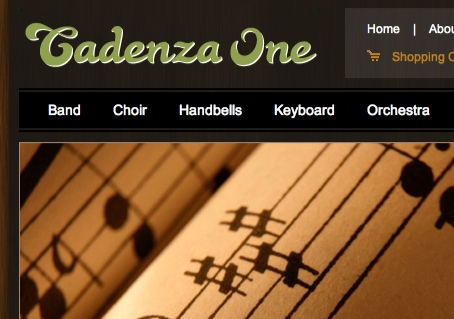 The Cadenza One site offers a new concept in digital sheet music, and they are anxious to tell you about it.
The Cadenza One site offers a new concept in digital sheet music, and they are anxious to tell you about it.
J. D. Frizzell, founder, explains:
I have spent my life’s savings (plus some) to build a comprehensive, easy-to-use, web site for both independent composers AND publishers. I knew that for any site to be truly successful, it needed to cater to the existing array of publishers while allowing more niche markets to be served. I also knew that it needed to require NO plug-ins, no log-ins, allow viewing and hearing of full scores on every product, and be less expensive than regular sheet music.
CadenzaOne.com is the result of that endeavor. This has become my passion project. I work on it late at night after all of my regular work is done. I stay passionate about the project because I see what a benefit it could be for the entire music community.
Read more:
As we began building the company from the ground up, we broke the industry down into its skeletal parts and the roles each part plays:– Composers and arrangers provide the content (often alongside lyricists or collaborators)
– Publishers curate the content, carve out a niche or brand, market the music to an audience, and edit and typeset the music for quality and uniformity.
– Retailers process payments, invoices, librarian accounts, and returns, help customers sort through hundreds if not thousands of choices, and deliver the content to the customer.
Right now, every single entity in that chain suffers from inefficiencies in the current printed distribution system. Consider a piece of music that sells for retail at $2.00 per copy. Retailers can buy a copy for somewhere between $1.00 and $1.40 from the publisher. Whether they can to sell it for the full MSRP of $2.00 or less depends on how high their overhead is, how much warehouse space they have, how big their order is with the publisher, and how much music they purchase each year from the publisher. So, they make somewhere between $.60 to $1.00 per copy and have to cover staffing, warehouse space, order fulfillment, packaging, and shipping. With the $1.00-$1.40 the publisher gets from that one copy, it must pay for printing, paper, editing, recording, marketing, the composer’s royalty of 20 cents, staffing, and building costs. That is not an easy task.
Contrary to what some may think, publishing sheet music is a low-margin business. Finally, the composer makes 20 cents, or 10 percent, of that $2.00 retail price. While this amount seems low, one can realize why it is this way– dozens of other expenses fill up the rest of the price of the music. Composers whose work is not mainstream enough to sell to a wide audience really have their work cut out for them. No matter how good their music is, if no one can find it and buy it, no one can perform it, and the composer cannot be compensated. There is very little financial incentive to write, and even less to write music that is difficult or different.
Here is how our system works:
– Composers write the music. If is still up to them if they send this music to a publisher for the services a publisher provides (marketing, editing, typesetting, recording, etc.).
– Composers or publishers submit their music to us through our proprietary systems. We have spent many months (and tens of thousands of dollars) developing these systems to quickly and easily create attractive, easy-to-use product pages automatically. We can convert an entire publisher’s catalog or one piece at a time.
– Customers can view and hear full scores on every piece without being able to steal.
– We sell digital copies to the customer in high-resolution PDF format. Each page of a licensed copy contains a detailed statement with the choir’s name and the number of copies they may have. All scores are fully compatible with iPad and all tablets. They also look great printed.
– Publishers and composers can log-in to our encrypted, secure server to view real-time sales data. – We also keep track of downloads to prevent theft, illegal sharing, and fraud.
– We sell pieces at a 10 to 25 percent discount off of MSRP. – We pay the composer or publisher 50 percent of MSRP. As publishers move more of their infrastructure into the digital realm, they can lower costs.
Best of luck, J.D.

